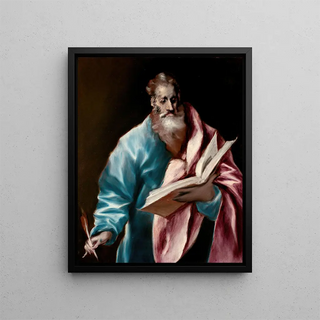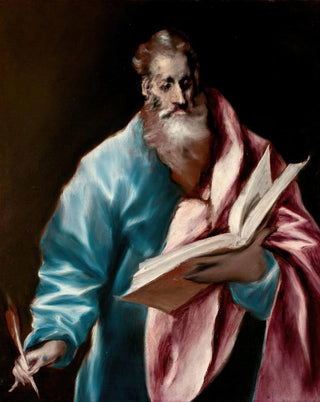Saint Matthew Apostle - El Greco Art print


View from behind

Frame (optional)
El Greco’s “Apostle Saint Matthew” is a masterpiece that transcends the simple realm of religious painting to become a profound exploration of spirituality and humanity. Created at the end of the 16th century, this work stands out for its emotional intensity and bold composition. As viewers contemplate this depiction of the saint, they are immediately drawn to Matthieu’s piercing gaze and expressive gesture, which seem to invite reflection on the divine and the earthly. The scene, imbued with mystery, offers an immersion into a world where light and shadow engage in a fascinating dance, revealing tensions between the sacred and the profane.
**Style and uniqueness of the work**
El Greco, master of Spanish Mannerism, deploys in “Apostle Saint Matthew” a palette of vibrant colors and a brushwork technique that are uniquely his own. The elongated figures and fluid contours testify to a distinctive style that defies the conventions of his time. The way light illuminates the saint’s face creates an almost supernatural atmosphere, giving the artwork a striking spiritual dimension. The choice of colors, ranging from deep blues to dazzling golds, heightens the drama of the scene while revealing the psychological depth of the character. Every detail, every fold of Matthieu’s robe, is carefully designed to convey emotion, a message, a quest for transcendence that still resonates today.
**The artist and his influence**
Dominique Theotocopoulos, known as El Greco, is an iconic figure in art history. Born in Crete, he mastered the blending of Byzantine and Western influences to create an inimitable style that continues to inspire generations of artists. His innovative approach to perspective and color marked a turning point in European art. By incorporating elements of mysticism into his works, El Greco not only redefined religious portraiture but also paved the way for future artistic movements, such as Baroque. His exploration of themes of spirituality and human identity still echoes in our contemporary era, where

Matte finish

View from behind

Frame (optional)
El Greco’s “Apostle Saint Matthew” is a masterpiece that transcends the simple realm of religious painting to become a profound exploration of spirituality and humanity. Created at the end of the 16th century, this work stands out for its emotional intensity and bold composition. As viewers contemplate this depiction of the saint, they are immediately drawn to Matthieu’s piercing gaze and expressive gesture, which seem to invite reflection on the divine and the earthly. The scene, imbued with mystery, offers an immersion into a world where light and shadow engage in a fascinating dance, revealing tensions between the sacred and the profane.
**Style and uniqueness of the work**
El Greco, master of Spanish Mannerism, deploys in “Apostle Saint Matthew” a palette of vibrant colors and a brushwork technique that are uniquely his own. The elongated figures and fluid contours testify to a distinctive style that defies the conventions of his time. The way light illuminates the saint’s face creates an almost supernatural atmosphere, giving the artwork a striking spiritual dimension. The choice of colors, ranging from deep blues to dazzling golds, heightens the drama of the scene while revealing the psychological depth of the character. Every detail, every fold of Matthieu’s robe, is carefully designed to convey emotion, a message, a quest for transcendence that still resonates today.
**The artist and his influence**
Dominique Theotocopoulos, known as El Greco, is an iconic figure in art history. Born in Crete, he mastered the blending of Byzantine and Western influences to create an inimitable style that continues to inspire generations of artists. His innovative approach to perspective and color marked a turning point in European art. By incorporating elements of mysticism into his works, El Greco not only redefined religious portraiture but also paved the way for future artistic movements, such as Baroque. His exploration of themes of spirituality and human identity still echoes in our contemporary era, where






